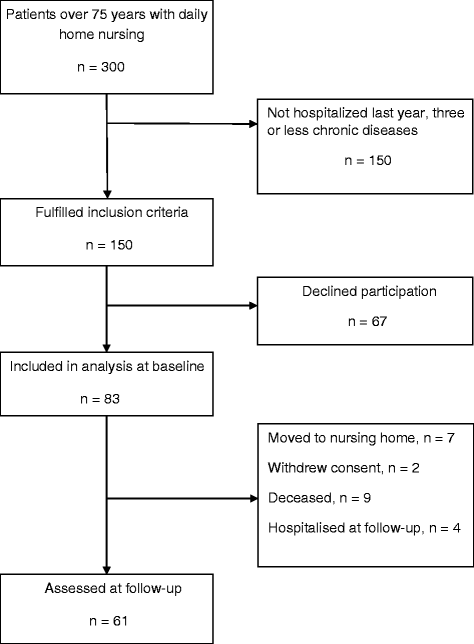Nursing care needs and services utilised by home-dwelling elderly with complex health problems: observational study
- PMID: 28899369
- PMCID: PMC5596938
- DOI: 10.1186/s12913-017-2600-x
Nursing care needs and services utilised by home-dwelling elderly with complex health problems: observational study
Abstract
Background: In Norway, as in many Western countries, a shift from institutional care to home care is taking place. Our knowledge is limited regarding which needs for nursing interventions patients being cared for in their home have, and how they are met. We aimed at assessing aspects of health and function in a representative sample of the most vulnerable home-dwelling elderly, to identify their needs for nursing interventions and how these needs were met.
Methods: In this observational study we included patients aged 75+ living in their own homes in Oslo, who received daily home care, had three or more chronic diagnoses, received daily medication, and had been hospitalized during the last year. Focused attention and cognitive processing speed were assessed with the Trail Making Test A (TMT-A), handgrip strength was used as a measure of sarcopenia, mobility was assessed with the "Timed Up-and-Go" test, and independence in primary activities of daily living by the Barthel Index. Diagnoses and medication were collected from electronic medical records. For each diagnosis, medication and functional impairment, a consensus group defined which nursing service that the particular condition necessitated. We then assessed whether these needs were fulfilled for each participant.
Results: Of 150 eligible patients, 83 were included (mean age 87 years, 25% men). They had on average 6 diagnoses and used 9 daily medications. Of the 83 patients, 61 (75%) had grip strength indicating sarcopenia, 27 (33%) impaired mobility, and 69 (83%) an impaired TMT-A score. Median amount of home nursing per week was 3.6 h (interquartile range 2.6 to 23.4). Fulfilment of pre-specified needs was >60% for skin and wound care in patients with skin diseases, observation of blood glucose in patients taking antidiabetic drugs, and in supporting food intake in patients with eating difficulties. Most other needs as defined by the consensus group were fulfilled in <10% of the patients.
Conclusions: We identified a very frail group of home-dwelling patients. For this group, resources for home nursing should probably be used in a more flexible and pro-active way to aim for preserving functional status, minimize symptom burden, and prevent avoidable hospitalisations.
Keywords: Community care; Elderly; Frailty; Functional decline; Home nursing; Multimorbidity; Polypharmacy.
Conflict of interest statement
Ethics approval and consent to participate
Ethics approval was obtained from the Regional Committee for Medical and Health Research Ethics (REK). Written informed consent was obtained from all participants.
Consent for publication
Not applicable.
Competing interests
The authors declare that they have no competing interests.
Publisher’s Note
Springer Nature remains neutral with regard to jurisdictional claims in published maps and institutional affiliations.
References
-
- Vegda K, Nie JX, Wang L, Tracy CS, Moineddin R, Upshur RE. Trends in health services utilization, medication use, and health conditions among older adults: a 2-year retrospective chart review in a primary care practice. BMC Health Serv Res. 2009;9:217. doi: 10.1186/1472-6963-9-217. - DOI - PMC - PubMed
Publication types
MeSH terms
LinkOut - more resources
Full Text Sources
Other Literature Sources
Miscellaneous


